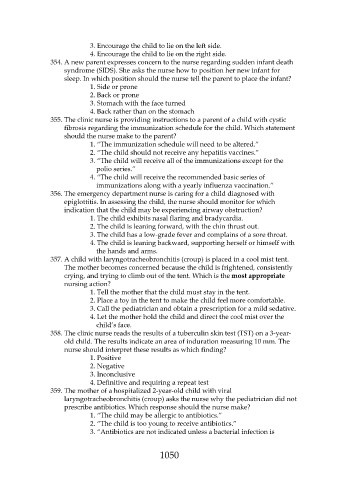Page 1050 - Saunders Comprehensive Review For NCLEX-RN
P. 1050
3. Encourage the child to lie on the left side.
4. Encourage the child to lie on the right side.
354. A new parent expresses concern to the nurse regarding sudden infant death
syndrome (SIDS). She asks the nurse how to position her new infant for
sleep. In which position should the nurse tell the parent to place the infant?
1. Side or prone
2. Back or prone
3. Stomach with the face turned
4. Back rather than on the stomach
355. The clinic nurse is providing instructions to a parent of a child with cystic
fibrosis regarding the immunization schedule for the child. Which statement
should the nurse make to the parent?
1. “The immunization schedule will need to be altered.”
2. “The child should not receive any hepatitis vaccines.”
3. “The child will receive all of the immunizations except for the
polio series.”
4. “The child will receive the recommended basic series of
immunizations along with a yearly influenza vaccination.”
356. The emergency department nurse is caring for a child diagnosed with
epiglottitis. In assessing the child, the nurse should monitor for which
indication that the child may be experiencing airway obstruction?
1. The child exhibits nasal flaring and bradycardia.
2. The child is leaning forward, with the chin thrust out.
3. The child has a low-grade fever and complains of a sore throat.
4. The child is leaning backward, supporting herself or himself with
the hands and arms.
357. A child with laryngotracheobronchitis (croup) is placed in a cool mist tent.
The mother becomes concerned because the child is frightened, consistently
crying, and trying to climb out of the tent. Which is the most appropriate
nursing action?
1. Tell the mother that the child must stay in the tent.
2. Place a toy in the tent to make the child feel more comfortable.
3. Call the pediatrician and obtain a prescription for a mild sedative.
4. Let the mother hold the child and direct the cool mist over the
child’s face.
358. The clinic nurse reads the results of a tuberculin skin test (TST) on a 3-year-
old child. The results indicate an area of induration measuring 10 mm. The
nurse should interpret these results as which finding?
1. Positive
2. Negative
3. Inconclusive
4. Definitive and requiring a repeat test
359. The mother of a hospitalized 2-year-old child with viral
laryngotracheobronchitis (croup) asks the nurse why the pediatrician did not
prescribe antibiotics. Which response should the nurse make?
1. “The child may be allergic to antibiotics.”
2. “The child is too young to receive antibiotics.”
3. “Antibiotics are not indicated unless a bacterial infection is
1050

